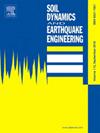Effect of soil-structure interaction on seismic earth pressure acting on building basements using 1g shaking table tests
IF 4.2
2区 工程技术
Q1 ENGINEERING, GEOLOGICAL
引用次数: 0
Abstract
The design of seismic earth pressures acting on basement walls has been conducted without taking soil–structure interactions (SSIs), especially the influence of the superstructure, into careful consideration. Accordingly, this study performed a series of 1 g shaking table tests to investigate the effect of SSI on the seismic pressure acting on basement walls. Three types of models—0-story, 3-story, and 9-story—that all contained the same three-story basement were used. The experimental models were organized into two groups: one simulating an embedded basement and the other simulating a basement fixed to bedrock. Three sinusoidal waves with different acceleration amplitudes were used as input motions. The tests evaluated the soil–basement displacement relationship, distribution and magnitude of seismic earth pressure, and the phase relationship between seismic thrust and building displacement, considering different building heights, input acceleration amplitudes, and basement fixity. The seismic earth pressure on basement walls varied with the soil–basement displacement relationship, increasing or decreasing from the initial static earth pressure depending on the relative displacement magnitudes. As the building height increased, the distribution of seismic earth pressure changed from triangular to inverted triangular, and the magnitude of seismic thrust increased by six times for embedded basements and about two times for fixed basements. The seismic earth pressure acted as a resisting force in low-rise buildings and as a driving force in the 9-story building. In the fixed basement cases, the trend was reversed, with seismic earth pressure acting as a driving force in the low-rise buildings and as a resisting force in the 9-story.
求助全文
约1分钟内获得全文
求助全文
来源期刊

Soil Dynamics and Earthquake Engineering
工程技术-地球科学综合
CiteScore
7.50
自引率
15.00%
发文量
446
审稿时长
8 months
期刊介绍:
The journal aims to encourage and enhance the role of mechanics and other disciplines as they relate to earthquake engineering by providing opportunities for the publication of the work of applied mathematicians, engineers and other applied scientists involved in solving problems closely related to the field of earthquake engineering and geotechnical earthquake engineering.
Emphasis is placed on new concepts and techniques, but case histories will also be published if they enhance the presentation and understanding of new technical concepts.
 求助内容:
求助内容: 应助结果提醒方式:
应助结果提醒方式:


